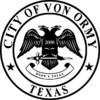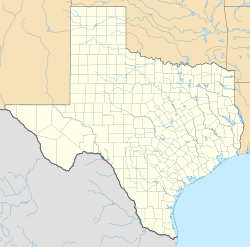Von Ormy, Texas facts for kids
Quick facts for kids
Von Ormy, Texas
|
|||
|---|---|---|---|
|
City
|
|||
| City of Von Ormy | |||
|
|||
| Motto(s): | |||
| Country | |||
| State | |||
| County | Bexar | ||
| Founded | 1827 by Blas Herrera | ||
| Incorporated | May 30, 2008 | ||
| Named for | Count Norbert Von Ormay | ||
| Government | |||
| • Type | Type C general law municipality | ||
| Area | |||
| • Total | 1.90 sq mi (4.92 km2) | ||
| • Land | 1.89 sq mi (4.89 km2) | ||
| • Water | 0.01 sq mi (0.03 km2) | ||
| Elevation | 614 ft (187 m) | ||
| Population
(2020)
|
|||
| • Total | 1,174 | ||
| • Density | 681.31/sq mi (263.09/km2) | ||
| Time zone | UTC-6 (Central) | ||
| • Summer (DST) | UTC-5 (Central) | ||
| Zip Code |
78073
|
||
| Area code(s) | 210, 726 (planned) | ||
| FIPS code | 48-75764 | ||
| GNIS feature ID | 2500157 | ||
| ANSI Code | 2500157 | ||
| Website | www.vonormytx.gov | ||
Von Ormy is a small city in southwest Bexar County, Texas, United States. It's part of the larger San Antonio area. In 2020, about 1,174 people lived there. The city's motto, Dios y Tejas, means "God and Texas" in Spanish.
Contents
About Von Ormy
The city has been known as Von Ormy since the late 1880s. Before that, it had other names like "Mann's Crossing" and "Garza's Crossing." These names came from important people or places where people crossed the Medina River. Two older settlements, Kirk and Bexar, became part of Von Ormy in the early 1900s.
History of Von Ormy
Early Days
Scientists have found signs that people have lived in the Von Ormy area for about 8,000 years! Native American groups like the Payaya and Pastia lived here first. Later, the Lipan Apache and Comanche tribes also lived along the Medina River. The river was important because it provided food, flint for tools, and other resources.
European settlers, including Spanish missionaries and soldiers, arrived in the early 1700s. They wanted to teach the native people about their ways. People from the Canary Islands also came to settle nearby San Antonio. They started raising cattle along the Medina River. Families like the Ruiz, Perez, and Navarro were among the first ranchers.
In the mid-1760s, Manuel Ruiz de Pesia started the first known cattle ranch in what is now Von Ormy. Later, in 1809, Ignacio Perez received a huge piece of land. A ranch house, which is now the site of the Von Ormy Castle, was built there.
In 1813, a big battle called the Battle of the Medina happened nearby during the Mexican War of Independence. Antonio López de Santa Anna, who later became famous, was a soldier in this battle and learned about the area.
In 1827, Blas Maria Herrera and his wife started the first lasting settlement in the area. People from Von Ormy were often listed in old church records as living "on the Medina." By the early 1800s, Von Ormy was a known community, a place where people crossed the Medina River on the important Camino Real road.
The Texas Revolution
During the War for Texas Independence, Santa Anna, who was then the Mexican president, camped in the future site of Von Ormy. This was right before he marched to the Alamo. There's a special tree, called the "Santa Anna Oak," where he camped. This huge tree was over 600 years old, but it fell in 2021.
Blas María Herrera, sometimes called the "Paul Revere of Texas," rode his horse from Laredo to San Antonio to warn everyone that Santa Anna was coming. Other local people also fought in the Texian Army, including Bernardindo Ruiz and Juan Martinez.
Republic of Texas and Early Statehood
After the war, the original doors of the Alamo were kept at the Herrera ranch until 1984. Then, a group called the Daughters of the Republic of Texas brought them back to the Alamo. The historic Ruiz-Herrera family cemetery is where Blas Herrera and Francisco Antonio Ruiz are buried. Francisco Antonio Ruiz was the mayor of San Antonio during the Alamo siege.
During the time of the Republic of Texas, the ranches along the Medina River grew. The first Catholic church in Von Ormy was built on Blas Herrera's ranch between 1836 and 1841. In 1866, it was rebuilt as the Santisima Trinidad Mission. You can still see parts of the old church today.
In the 1850s, Miguel de la Garza ran a ferry to cross the Medina River. This is why the town became known as Garza's Crossing.
Civil War and After
During the American Civil War, people in Von Ormy had mixed feelings about joining the Confederacy. Many German and Mexican Catholics in the area did not support leaving the Union. In 1861, local people formed a cavalry group called the Medina Guards. This group was made up of both Tejano (Texans of Mexican heritage) and Anglo/German soldiers. They fought in battles in New Mexico.
Before the Civil War, a wealthy merchant named Enoch Jones built a strong ranch house next to the old Ignacio Perez ranch, which people called "the Castle on the Medina." He died in 1863, and his land was sold to pay debts.
After the war, Von Ormy became an important place for trade. There was a big demand for beef in the North, so many cattle drives started in South Texas. This brought new families from northern Mexico to the area, who worked as cowboys and ranch hands.
The town's post office opened in 1872 as "Garza's Crossing." It closed and reopened a few times, changing names to "Mann's Crossing" and then finally to "Von Ormy" on December 4, 1886. The name "Von Ormy" has stayed ever since.
Later Years and Growth
In 1886, the "castle" was sold to Count Norbert Von Ormay, a count from the Austro-Hungarian Empire. The city was named after him.
The International–Great Northern Railroad built a train line near Von Ormy in 1886. At first, they called the town "Medina Station," but by 1900, they went back to using "Von Ormy." Over time, more people moved closer to the train line.
In 1906, the first steel bridge was built over the Medina River in Von Ormy. A Texas Ranger and judge named W. G. M. Samuel, who lived in Von Ormy, often said that the last major Native American battle in Bexar County happened in Von Ormy.
In the early 1900s, a special hospital for people with tuberculosis, called the Von Ormy Cottage sanitarium, was built in the city. The Von Ormy school was open until 1956, when it closed after the Southwest Independent School District was created. By 1914, Von Ormy had two grocery stores, a general store, a cotton gin, and about 350 people.
Hurricane of 1919
The Santisima Trinidad Church was destroyed by a big hurricane in 1919. A new church was built nearby in the 1910s. However, this stone church was later torn down in the 1930s when the Laredo Highway was made wider to become Interstate 35. The church that stands today was built in the 1960s and is called Sacred Heart of Jesus.
Becoming a City
In 2006, some Von Ormy residents started meeting to talk about the community's future. They wanted better public services. Many people supported the idea of Von Ormy becoming its own city. A group called the Committee to Incorporate Von Ormy (CIVO) was formed.
CIVO worked with the City of San Antonio to allow an election for Von Ormy to become a city. On May 10, 2008, people voted, and 88% said "yes" to creating the City of Von Ormy.
In 2008, Art Martinez de Vara became the first mayor of Von Ormy. He was one of the youngest mayors in the United States and his family had lived in Von Ormy for six generations. During his time as mayor, the city cut taxes by 10% each year for four years in a row.
In 2010, TV personality Chris Marrou became an associate judge for the city.
Von Ormy Today
Von Ormy used to have a growing film industry. In 2013, a newspaper called the San Antonio Express-News even named Von Ormy the "Farm Film Capitol of South Texas." However, the Von Ormy Film Commission stopped operating in 2020.
According to Mayor Sally Martinez in 2019, a lot of the city's money comes from sales tax. A smaller amount comes from traffic tickets on I-35.
Geography and Location
Von Ormy is located along the Medina River. It's where the old Camino Real road used to cross the river. Today, Interstate 35 goes through the city, with exits at 140 and 141. I-35 leads about 15 miles northeast to downtown San Antonio and 143 miles southwest to Laredo.
Population Information
| Historical population | |||
|---|---|---|---|
| Census | Pop. | %± | |
| 2010 | 1,085 | — | |
| 2020 | 1,174 | 8.2% | |
| U.S. Decennial Census | |||
| Race | Number | Percentage |
|---|---|---|
| White (NH) | 125 | 10.65% |
| Black or African American (NH) | 5 | 0.43% |
| Native American or Alaska Native (NH) | 2 | 0.17% |
| Asian (NH) | 3 | 0.26% |
| Some Other Race (NH) | 5 | 0.43% |
| Mixed/Multi-Racial (NH) | 4 | 0.34% |
| Hispanic or Latino | 1,030 | 87.73% |
| Total | 1,174 |
In 2020, there were 1,174 people living in Von Ormy. There were 262 households and 210 families.
At the 2010 United States Census, there were 1,085 people. Most of the people living in Von Ormy were of Hispanic or Latino background, making up 86.4% of the population.
See also
 In Spanish: Von Ormy (Texas) para niños
In Spanish: Von Ormy (Texas) para niños





